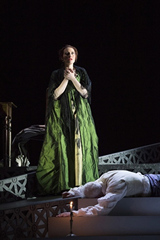| Opera Reviews | 30 April 2024 |
ETO's Tosca conveys the inexorable progress to tragedyby Catriona Graham |
|
Puccini: Tosca
|
|
|
Cavaradossi himself (Samuel Sakker) is matter-of –fact when he finds the escaped prisoner Angelotti (Timothy Connor) in the chapel; the same when Tosca recognises another woman in the painting her lover is working on; equable in the face of the Sacristan’s grumbling and mumbling (Matthew Stiff). Florence de Mare’s ingenious set features steps, a slope, a balustrade and column in lattice-work which, with the addition of suitable props, does service for Sant’ Andrea della Valle, the Palazzo Farnese and the Castel Sant’ Angelo. The production is set, like the opera, in 1800, before electricity was used for illumination, and the dimness of Mark Howland’s lighting enhances the sense of deeds done in darkness. There is little colour in the piece, apart from local child choristers in red and white, supplementing the chorus for the grand processional at the end of Act I. And, of course, Floria Tosca herself, in a grassy-green gown for Acts II and III. Under conductor Michael Rosewell, the orchestra creates a real sense of menace and foreboding underpinning the processional and Scarpia’s soliloquy. Craig Smith’s police chief is no moustache-twirling villain, as he plots the capture and execution of Angelotti and getting his hands on Tosca. In the confrontation between Cavaradossi – who has hidden Angelotti at his villa – and Scarpia, both are implacable, but Scarpia has the power. He plays with and on Tosca’s emotions, offering Cavaradossi’s life for her body; there is an unpleasant feeling that he is getting off on her anguish. In one of the loveliest moments in the opera, Vissi d’arte, Sides sings with great stillness and resignation, a bit wistful, and a bit of despair. On spying a knife, she visibly screws her courage to the point when she can stab Scarpia, then panics, scrabbling round to locate the safe-conduct she asked him for. Finally, we are at Castel Sant’Angelo, before dawn, when Cavaradossi is to be executed – only, Scarpia had convinced Tosca that it would be fake. More routine sentinel changes and paperwork, and Cavaradossi writes a last note to Tosca, touchingly sung by Sakker. When Tosca rushes in and is given a few moments with Cavaradossi, she is clearly still in shock from the murder. And so, the execution was for real, as is Tosca’s dawning realisation of the fix she is in, as distant voices make it clear Scarpia’s body has been found. There is no escape, except to jump. And yet this low-key production, lacking the impassioned grand gestures one might expect, conveys, by its very ordinariness, the inexorable progress to tragedy foretold by those first doom-laden notes with which the opera began.
|
|
| Text ©
Catriona Graham Photo © Richard Hubert Smith |

 Tosca is a diva. We know this – one of the other characters in Puccini’s opera even uses the word about her – so we might expect some diva-esque histrionics. But not in English touring Opera’s current production, directed by Blanche McIntyre. Paula Sides is kittenish, rather than a tiger. In scenes with her lover, the painter Cavaradossi, she is gentle and domestic.
Tosca is a diva. We know this – one of the other characters in Puccini’s opera even uses the word about her – so we might expect some diva-esque histrionics. But not in English touring Opera’s current production, directed by Blanche McIntyre. Paula Sides is kittenish, rather than a tiger. In scenes with her lover, the painter Cavaradossi, she is gentle and domestic.






